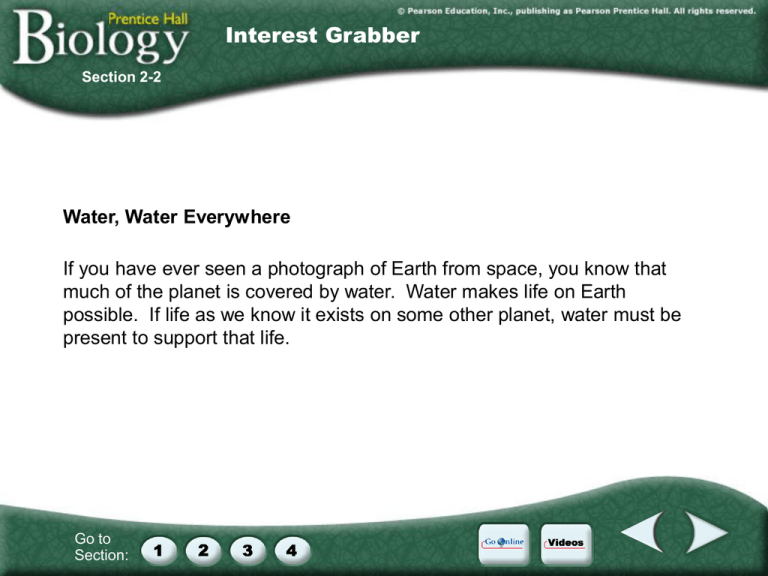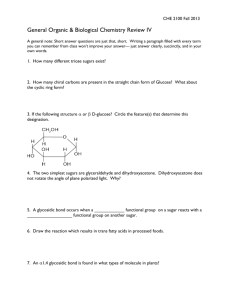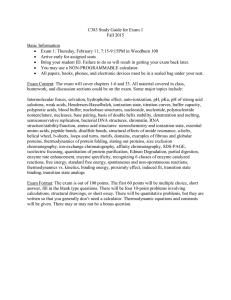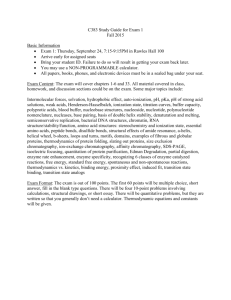Section 2-4
advertisement

Interest Grabber Section 2-2 Water, Water Everywhere If you have ever seen a photograph of Earth from space, you know that much of the planet is covered by water. Water makes life on Earth possible. If life as we know it exists on some other planet, water must be present to support that life. Go to Section: Interest Grabber continued Section 2-2 1. Working with a partner, make a list of ten things that have water in them. 2. Exchange your list for the list of another pair of students. Did your lists contain some of the same things? Did anything on the other list surprise you? 3. Did either list contain any living things? Go to Section: Objective: You will be able to differentiate between inorganic and organic compounds. Do Now: Read all of page 44 Explain why carbon can create so many different kinds of molecules Go to Section: Inorganic versus Organic compounds Go to Section: Types of Organic Compounds Carbohydrates Lipids Proteins Nucleic Acids Go to Section: An Element in the Periodic Table Section 2-1 6 C Carbon 12.011 Go to Section: Molecular Diversity Arising from Carbon Skeleton Variation (a) Length H H H C C H H H H H H H C C C H H H Ethane H Propane H H (b) Branching H H H H H C C C C H H H H H H H H H H H H C C C C H H (d) Rings Figure 4.5 A-D Go to Section: H H H H C C C C C C C C H H H H H H H H C C C C H H 2-Butene H H C H H 1-Butene H H H H H H Cyclohexane H 2-methylpropane (commonly called isobutane) Butane (c) Double bonds C H C C C C C Benzene H H Go to Section: Go to Section: Go to Section: Go to Section: Objective: You will be able to describe the structure and function of carbohydrates Do Now: Read “Macromolecules” on p. 45 Differentiate between monomers and polymers Go to Section: Functions – Readily available source of energy – Energy storage – Strong building materials Go to Section: Structure – Consists of carbon, hydrogen and oxygen – Hydrogen and oxygen are always in a 2:1 ratio – Can have a linear or a ring structure Go to Section: Figure 5.2 The synthesis and breakdown of polymers Go to Section: Figure 5.5 Examples of disaccharide synthesis Go to Section: Figure 2-13 A Starch Section 2-3 Starch Glucose Go to Section: Figure 5.6 Storage polysaccharides Go to Section: Figure 5.9 Chitin, a structural polysaccharide: exoskeleton and surgical thread Go to Section: Lipids have several functions: Long term energy storage Make up cell membranes Work as steroids Go to Section: Structure of Lipids Consists of one glycerol and three fatty acids Fatty acids are long chains of carbon and hydrogen Greater than 2:1 ratio of hydrogen to oxygen Go to Section: Figure 5.10 The synthesis and structure of a fat, or triacylglycerol Go to Section: Go to Section: Figure 5.11 Examples of saturated and unsaturated fats and fatty acids Go to Section: Figure 5.14 Cholesterol, a steroid Go to Section: Objective: You will be able to describe the structure and function of nucleic acids. Do Now: •Read “Nucleic Acids” on p. 47 •List the parts of a nucleotide Go to Section: Nucleoside Nitrogenous base O O P 5’C O CH2 O O Phosphate group Figure 5.26 Go to Section: (b) Nucleotide 3’C Pentose sugar DNA 1 Synthesis of mRNA in the nucleus mRNA NUCLEUS CYTOPLASM mRNA 2 Movement of mRNA into cytoplasm via nuclear pore 3 Go to Section: Figure 5.25 Ribosome Synthesis of protein Polypeptide Amino acids Go to Section: Figure 2-16 Amino Acids Section 2-3 Amino group Carboxyl group General structure Go to Section: Alanine Serine Figure 2-16 Amino Acids Section 2-3 Amino group Carboxyl group General structure Go to Section: Alanine Serine Concept Map Section 2-3 Carbon Compounds include Carbohydrates Lipids Nucleic acids Proteins that consist of that consist of that consist of that consist of Sugars and starches Fats and oils Nucleotides Amino Acids which contain which contain Carbon, hydrogen, oxygen Go to Section: Carbon, hydrogen, oxygen which contain which contain Carbon,hydrogen, oxygen, nitrogen, phosphorus Carbon, hydrogen,oxygen, nitrogen, Figure 2-16 Amino Acids Section 2-3 Amino group Carboxyl group General structure Go to Section: Alanine Serine Figure 2-17 A Protein Section 2-3 Amino acids Go to Section: Interest Grabber Section 2-4 Matter and Energy Have you ever sat around a campfire or watched flames flicker in a fireplace? The burning of wood is a chemical reaction—a process that changes one set of chemicals into another set of chemicals. A chemical reaction always involves changes in chemical bonds that join atoms in compounds. The elements or compounds that enter into a chemical reaction are called reactants. The elements or compounds produced by a chemical reaction are called products. As wood burns, molecules of cellulose are broken down and combine with oxygen to form carbon dioxide and water vapor, and energy is released. Go to Section: Interest Grabber continued Section 2-4 1. What are the reactants when wood burns? 2. What are the products when wood burns? 3. What kinds of energy are given off when wood burns? 4. Wood doesn’t burn all by itself. What must you do to start a fire? What does this mean in terms of energy? 5. Once the fire gets started, it keeps burning. Why don’t you need to keep restarting the fire? Go to Section: Section Outline Section 2-4 2–4 Chemical Reactions and Enzymes A. Chemical Reactions B. Energy in Reactions 1. Energy Changes 2. Activation Energy C. Enzymes D. Enzyme Action 1. The Enzyme-Substrate Complex 2. Regulation of Enzyme Activity Go to Section: Effect of Enzymes Section 2-4 Reaction pathway without enzyme Activation energy without enzyme Reactants Reaction pathway with enzyme Activation energy with enzyme Products Go to Section: Figure 2-19 Chemical Reactions Section 2-4 Energy-Absorbing Reaction Energy-Releasing Reaction Activation energy Products Activation energy Reactants Reactants Products Go to Section: Figure 2-19 Chemical Reactions Section 2-4 Energy-Absorbing Reaction Energy-Releasing Reaction Activation energy Products Activation energy Reactants Reactants Products Go to Section: Figure 2-21 Enzyme Action Section 2-4 Enzyme (hexokinase) Glucose Substrates Products ADP Glucose-6phosphate Products are released ATP Active site Enzyme-substrate complex Substrates are converted into products Go to Section: Substrates bind to enzyme Figure 2-21 Enzyme Action Section 2-4 Enzyme (hexokinase) Glucose Substrates Products ADP Glucose-6phosphate Products are released ATP Active site Enzyme-substrate complex Substrates are converted into products Go to Section: Substrates bind to enzyme Figure 2-21 Enzyme Action Section 2-4 Enzyme (hexokinase) Glucose Substrates Products ADP Glucose-6phosphate Products are released ATP Active site Enzyme-substrate complex Substrates are converted into products Go to Section: Substrates bind to enzyme Figure 2-21 Enzyme Action Section 2-4 Enzyme (hexokinase) Glucose Substrates Products ADP Glucose-6phosphate Products are released ATP Active site Enzyme-substrate complex Substrates are converted into products Go to Section: Substrates bind to enzyme Videos Click a hyperlink to choose a video. Atomic Structure Energy Levels and Ionic Bonding Covalent Bonding Enzymatic Reactions Go Online Career links on forensic scientists Interactive test Articles on organic chemistry For links on properties of water, go to www.SciLinks.org and enter the Web Code as follows: cbn-1022. For links on enzymes, go to www.SciLinks.org and enter the Web Code as follows: cbn-1024.





